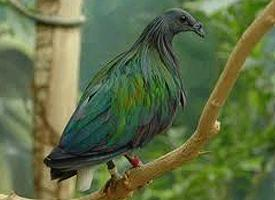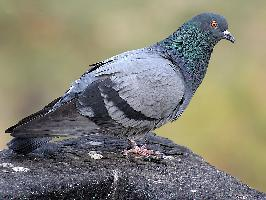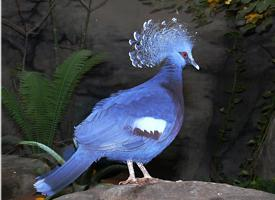
Greutăți și măsuri
| Lungime | 33 cm |
|---|
Descrierea animalului
The Nicobar pigeon (Caloenas nicobarica) is a strikingly beautiful bird, known for its vibrant plumage and unique appearance. As the closest living relative to the extinct dodo, this species holds a particular fascination for ornithologists and bird enthusiasts alike. Native to the coastal regions and islands of the Indian and Pacific Oceans, the Nicobar pigeon has adapted to a variety of habitats, ranging from dense tropical forests to mangroves and beach scrubs.One of the most distinctive features of the Nicobar pigeon is its iridescent plumage. The bird boasts an array of shimmering colors that change and glisten in the sunlight. The feathers on its body are predominantly a dark, metallic green and blue, with a unique coppery sheen. The bird's mane, which is a dense ring of feathers around its neck, adds to its majestic appearance, displaying hues of copper and green. Its tail is short and white, a stark contrast to the darker colors of its body, which adds to the bird's striking appearance.
The Nicobar pigeon is a relatively large bird, with a robust body and strong legs. It measures approximately 40 cm in length, making it one of the larger pigeon species. The bird's beak is another notable feature; it is thick and strong, with a small hook at the tip, which is perfectly adapted for its diet. Unlike many other pigeon species, the Nicobar pigeon is a ground feeder, primarily consuming seeds, fruits, and occasionally small invertebrates, which it forages from the forest floor.
Social behavior is a key aspect of the Nicobar pigeon's life. These birds are highly gregarious, often found in flocks that can number in the hundreds. This social structure plays a crucial role in their survival, providing protection from predators and aiding in the search for food. The flocks roost together at night on offshore islets, which offer safety from terrestrial predators, and fly to mainland areas or larger islands during the day to feed.
Breeding behavior of the Nicobar pigeon is also noteworthy. They are monogamous, with pairs forming strong bonds. The breeding season varies depending on their location but generally coincides with the onset of the rainy season, which ensures an abundant supply of food for their chicks. Nests are usually constructed on the ground or in low branches and are made from twigs, leaves, and other plant materials. Females typically lay a single white egg, which both parents take turns incubating.
Despite their beauty and ecological significance, Nicobar pigeons face threats from habitat loss and degradation, hunting, and predation by introduced species. Their dependence on small islands for roosting makes them particularly vulnerable to human activities and invasive predators, such as rats and cats. Conservation efforts are underway in some areas to protect their habitats and manage threats, but more widespread action is needed to ensure the survival of this remarkable species.
In summary, the Nicobar pigeon is a captivating bird, with its iridescent plumage, robust build, and unique ecological adaptations. Its significance as a close relative of the dodo adds to the urgency of conserving this species and its habitat, ensuring that it continues to thrive in its natural environment.
Animale similare
Fotografii noi cu animale
Top 10 animale
- Diana monkey (Cercopithecus diana)
- Dolphin gull (Leucophaeus scoresbii)
- Galápagos tortoise (Geochelone nigra complex)
- Moustached guenon (Cercopithecus cephus)
- Japanese spider crab (Macrocheira kaempferi)
- Colossal squid (Mesonychoteuthis hamiltoni)
- Fox tapeworm (Echinococcus multilocularis)
- Stone loach (Barbatula barbatula)
- Japanese macaque (Macaca fuscata)
- Barbary macaque (Macaca sylvanus)


